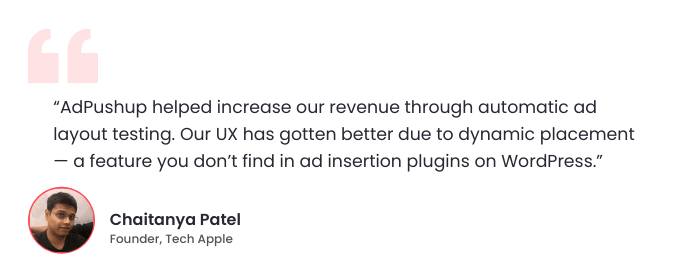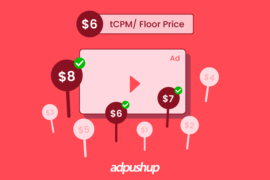Users install ad blockers for a number of reasons. Some do it because they find ads annoying or intrusive while others want to safeguard their privacy and security. Publishers see ads as a source of revenue from the traffic coming to their websites or applications, so they don’t always prioritize user experience and data security.
Neglecting the needs of users leads to the adoption of ad blockers. Every year, new statistics show what ad blockers cost publishers. Digiday predicts that ad blockers will cost publishers $35 billion in 2020. It’s important for publishers to educate themselves about what users want and why they install ad blockers in the first place.
Here are some common reasons why users install ad blockers:
There are Simply Too Many Ads
Digital advertising has a reputation for being intrusive. While we don’t see many intrusive ad formats now, thanks to the Better Ads Standards and ad tech vendors being more mindful about this—there was a time when websites were filled with such ads.
These ads are being slowly filtered out from the ad tech supply chain, but the discomfort caused by them still persists in users’ minds. And then we still have websites with too many ads, if not necessarily the overly intrusive type. According to research by Google, 63% users install ad blockers because they are inundated with online ads.
What publishers can do?
In recent times, governments and industry bodies have been stepping in to fix the mess created by ad tech. adChoice, an initiative by the IAB, gives users the ability to choose whether or not they want to see ads. Similarly, privacy regulations such as GDPR and CCPA allow users to choose whether or not they want to share their behavioral data with advertising companies.
Publishers, on their part, should ensure compliance with these policies and create a transparent environment by giving users the right to choose their online experience. Some publishers may worry that compliance will cost them a share of their ad revenue. However, in the long run, this effort will be in favor of publishers, as users trust them more because of the choice and transparency being offered to them.
Users are Overwhelmed by Intrusive Ads
Even after industry efforts to improve ad experience, the web is far from clean. You can still see large sticky ads and autoplay video ads on the desktop with the sound on. And similarly, pop-up ads and flashy animated ads are frequently seen on mobile. The previously shared research says that 48% users install ad blockers to avoid seeing such intrusive ads.
There is no exact definition of intrusive ads. While an intrusive ad for one user may be relevant to another, the Better Ads Standards suggests some formats are generally intrusive and undesirable.
What publishers can do?
To start with, publishers need to stay in sync with Better Ads Standards. For instance, autoplay video ads with sound on have been marked as one of the most intrusive ad formats. Publishers that still use these ad formats should reconsider their ad layout. Sometimes, while focusing on content and revenue generation, publishers overlook users. Be mindful of the ad experience you are delivering to end users.
Privacy Concerns
Users are now getting familiar with the concept of retargeting. There was a time when we all felt followed by a pair of shoes after we checked them out on an eCommerce website. Now, we don’t get so alarmed. But it does raise questions about the type of user details websites are collecting. Hence, to avoid being followed everywhere, users install ad blockers. Here, cookie targeting and ad blocking are different but related issues.
Storing and using personal data without user knowledge and consent sounds bad, right? However, for a long time, user data has been used without explicit permission. This has reflected badly on ad tech, due to which we now see web browsers like Firefox and Safari taking harsh measures like cookie blocking. If users can’t stop companies from saving their data, they handle the privacy breach by installing ad blockers.
What publishers can do?
Asking for permission to store and use cookies should be the first step for publishers. In fact, it is now mandated by government regulations in some regions (Like EU and California state). Next, publishers should assure users that their data is safe from third-parties. Finally, update the cookie policy, keeping user security in mind.

Using Browsers with Pre-installed Ad Blockers
Web browsers like Brave, Opera, and UC Browser have pre-installed ad blockers. Many browsers promote their solution as secure and ad-free to encourage users into using them. Using these browsers means blocking ads, leading to direct revenue loss for publishers. Similarly, many antivirus applications also provide ad blocking functionality. In these cases, users knowingly or unknowingly block ads, without actually installing ad blockers directly.
What publishers can do?
The Google research shows that 30% users don’t install ad blockers on their own, while 54% don’t know about ‘whitelist websites.’ In this case, publishers can inform users about the ad blockers running within their browser. Publishers should also make efforts to educate their users about anti-ad blocking technology and its consequences for the publishing community.
Slow Loading Webpages
Ads that take a long time to render contribute to increased page latency. 3 seconds is all it takes for users to move on to another webpage if it’s too slow to load. Users who are conscious of page load times or those working with a slower connection install ad blockers to experience a quicker page load time.
What publishers can do?
Publishers should design ad layouts carefully in order to optimize ad rendering time. As publishers partner with multiple ad networks, ad exchanges, SSPs and ad servers, it’s advisable to get professional ad ops expertise to get the task done efficiently. Furthermore, publishers can take the help of open source services like Google Lighthouse to check the performance of their webpage.
What’s the Learning for Publishers
Lately, anti-adblock measures are gaining popularity in ad tech. We have options like paywalls, whitelisting, and native ads to monetize adblock users.
However, these are short-term solutions. A long-term solution would be users giving up on the use of ad blockers, willingly. This sounds too good to be true, but it’s not impossible.
Here’s why:
Users come for content: The reason publishers get traffic is because of user interest in their content. Hence, the need for quality content will always exist. If users find your content valuable, and if you make the effort to educate them about your business–many users will choose to support you by whitelisting your website.
Users don’t mind paying: Digiday conducted a survey with 135 publishers, where they were asked about their revenue sources. More than 14% publishers marked subscription as their second-highest revenue source after programmatic deals and direct-sold ads.
Also, 46% of publishers suggested 2020 will be the year when they focus on increasing subscriptions. This proves that many users happily pay for quality content, as opposed to free content supported by ads.
Users don’t hate all ads, just the bad ones: Sometimes, ads help users reach the product or service they were looking for. Meaning, they don’t necessarily hate ads. However, users get triggered and install ad blockers when ads begin to disrupt their online experience.
Users don’t realize the cons of using ad blockers: Ad blockers are not all good. They prevent the interruption of ads, but they have their own ways of tracking users and collecting personal data. Furthermore, ad blocking software code is vulnerable to security lapses—just like any other software. As a measure, publishers should educate users about the hidden disadvantages of using ad blockers from their point of view.

Shubham is a digital marketer with rich experience working in the advertisement technology industry. He has vast experience in the programmatic industry, driving business strategy and scaling functions including but not limited to growth and marketing, Operations, process optimization, and Sales.








1 Comment
Thanks for sharing this useful and helpful information…!!!